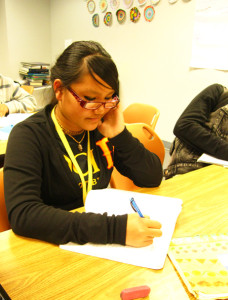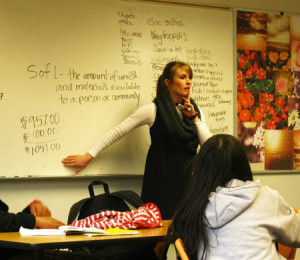Share This Article
The nation dedicates the month of April to promoting financial literacy. Financial institutions across the country are offering short quizzes, providing resources, and drawing attention to the need for widespread money lessons in schools.
Some parents may be asking, “With all the concepts that teachers have to focus on – math, geography, history and more – why should personal financial literacy be taught in the classroom? Isn’t personal finance just that — personal?”
Financial lessons may start at home, but here are ten reasons why we think financial literacy has a home in the classroom.
The countdown…
10. Kids have purchasing power. Children start spending money and making spending choices really early in their development. No longer is it necessary to wait until they have a steady allowance or a job to discuss their spending decisions. Because parents often send their children off with lunch money on class field trips or to movies with other friends and their parents, kids are handling cash well before they get their first paycheck. Even when parents are with their kids in the grocery store, kids are making purchasing requests. It’s important for youth to understand the power they have and to start making decisions about their wants and needs at a very young age.
9. Let’s educate them when the stakes are small. Defaulting on a car loan at age 21 could spell recipe for disaster. If a child is encouraged to take out a loan for something small like an iPad at age 12, any missed payments can be a lesson – not a burden to be carried for years after.
8. Are all parents truly comfortable teaching personal finance? Without a doubt, parents are an important partner in this process. However two in five U.S. adults gave themselves a C, D, or F on their knowledge of personal finance. I know many of my peers and colleagues weren’t educated about financial topics at home. They learned later in life through trial and error. Thus, many don’t know how to teach their children about money at age-appropriate levels.
7. Student loan costs are on the rise. Planning ahead for college is a vital step to future financial freedom. It is important that our children are educated about opportunities available to save for higher education, as well as the costs and benefits of student loan debt, to allow for informed decision making.
6. Debt is more prevalent than ever. Knowing what debt is, how to manage it, how to pay it off, and how to avoid it are crucial lessons to learn at an early age. Adults carry on average more than $15,000 in credit card debt, according to the Federal Reserve. Most say they regret taking on that debt and would encourage their children to live within their means. If young people can grasp the consequences of the interest payments and carrying a balance early on, they may be able to avoid these burdens.
5. The rise of online banking and virtual transactions may mean that kids miss the basic concepts. Many people don’t use a check book anymore because all financial transactions can be viewed through a bank’s website. However, youth don’t often grasp the concept of withdrawals and the timing of transaction, and this lack of understanding is exacerbated with online banking. Over one-fourth of children look at their bank accounts online. That means those youth who don’t quite understand the “money in, money out” concept can fall into the trap of over drafting. However, if young people learn the nuances of timing and understand withdrawals early, they’ll make far fewer mistakes later on.
4. Mistakes can be made at a young age. Did you know that returning a library book late dents your credit score? Young people are building credit from a young age with simple interactions. It’s important for them to understand how their actions affect their long-term financial success.
3. “Paying Yourself First” never goes out of style. Saving will always be a crucial part of life. Why not start the habit early? Everyone is encouraged to take the first 10% of any money earned or received and put it directly into savings. Of course, more than 10% can be saved, but by taking that first 10% before anything is purchased or paid, everyone can assure themselves of a healthy savings account.
2. Classrooms allow everyone to learn financial concepts on the same playing field. Parents have different experiences and youth have different opportunities. In the T. Rowe Price “Annual Parents, Kids and Money” survey, results showed that males were far more likely than females to feel comfortable with financial concepts like diversification and asset allocation. However, with financial literacy lessons in the classroom, both boys and girls can grasp an understanding of these and other concepts. When everyone learns the same lessons, we can all get a healthy head start.
1. This could be the key to avoiding another economic meltdown. Learning how to make smart financial decisions when it comes to managing a budget, taking out a loan or making credit card purchases is no less important than learning about history and geography.
Want more?
Parents – If you are interested in learning more about how to talk to your kids about money, check out one of our Money Matters classes, sponsored by Great-West Great-Teachers, a program of Great-West Financial.
Sources:
National Foundation for Credit Counseling, Inc., Financial Literacy Survey Exposes Significant Gaps In Grasp Of Personal Finance Skills, April 2012, http://www.nfcc.org/newsroom/newsreleases/SIGNIFICANT_GAPS.cfm
Statistic Brain, Sourced from Federal Reserve, Join Economic Committee, Sallie Mae, TransUnion, July 24, 2013, http://www.statisticbrain.com/credit-card-debt-statistics/
DoughMain, Study Reveals Need for Tools to Help Parents Teach Kids About Savings, February 17, 2012, http://bit.ly/zLuiq9
5th Annual Parents, Kids and Money Survey, T.Rowe Price, March 2013, http://media.moneyconfidentkids.com/wp-content/uploads/2013/03/PKM-Survey-Results-Report-FINAL-0326.pdf





